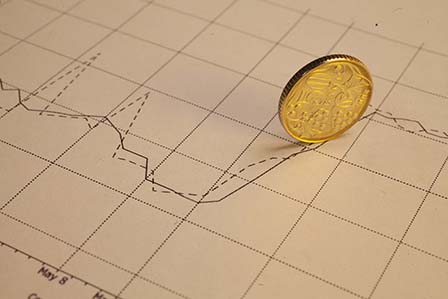According to the data published by the National Bureau of Statistics (NBS), in March 2015, the consumer prices index (CPI) for the last 12 months constituted 7.1 percent, increasing by 0.6 percentage points compared to the previous month and exceeding the upper limit of the range of variation of ± 1.5 percentage points from the 5.0 percent target.
The balance of risks to inflation in the medium term is affected by a complex number of internal and external factors, with prevalence of the pro-inflationary risks. The weak economic activity of the euro area countries and the recession of the Russian Federation – the major trading partners of the Republic of Moldova, lead to risks of lower household and domestic exporters income on short-term through the external trade channel and remittances. This may further influence the dynamics of the national currency exchange rate and, subsequently, the inflation dynamics. The intensification of geopolitical tension in the region may generate additional inflationary pressures.
The depreciation of the national currency from the beginning of this year accentuates the inflationary pressures, which the next periods, determine CPI to leave temporarily the upper limit of the range of variation of ± 1.5 percentage points from the 5.0 percent target, through the prices of imported goods and tariffs for regulated services, and subsequently through the second-round effects.
The annual rate of inflation in March was 7.1 percent, increasing by 0.6 percentage points compared to the previous month and by 1.4 percentage points higher than in March 2014. This dynamics was mainly due to the contribution from core inflation and food prices, of 3.6 and 2.4 percentage points, respectively. The regulated prices and fuels contributed to annual inflation by 0.7 and 0.4 percentage points, respectively.
The monthly inflation rate recorded the level of 0.9 percent, being mainly determined by the increase in food prices by 1.3 percent, non-food prices by 0.9 percent and tariffs for public services by 0.2 percent.
The annual core inflation recorded a level of 10.6 percent in March 2015, increasing by 0.4 percentage points compared to the previous month.
In March 2015, the monthly core inflation rate was 0.7 percent. The most significant price increases related to core inflation were recorded by detergents, sanitary and hygiene articles, knitwear, clothing and building materials.
Food prices in the reporting month increased by 1.3 percent compared to the previous month. This dynamics was driven by the increase in the prices of fresh fruits by 6.8 percent, sugar by 5.3 percent, fresh vegetables by 4.4 percent, non-alcoholic drinks by 3.4 percent, potatoes by 3.2 percent, fish and canned fish by 2.7 percent and milling and bakery products by 1.6 percent. At the same time, these increases were mitigated by the decrease in prices of eggs by 20.9 percent.
Excluding seasonal factors, food prices increased by 1.2 percent compared to February, mainly due to the depreciation of the national currency against the U.S. dollar during the last months.
The annual growth rate of food prices was 7.0 percent, by 1.0 percentage points higher compared to February 2015 and by 1.5 percentage points lower than in March 2014.
In March 2015, fuel prices increased by 0.6 percent compared to the previous month. This dynamics was mainly due to the increase in fuel prices by 2.1 percent, as a result of the increase in petrol and diesel prices conducted by oil companies in February. However, the bottled gas prices decreased by 0.8 percent. At the same time, the prices of earth coal, firewood and liquid fuel remained at the previous month level.
The annual growth rate in fuel prices was 5.3 percent, by 0.1 percentage points lower to the value recorded in February 2015 and by 2.1 percentage points higher than in March 2014.
In the analyzed period, the prices for regulated services increased by 0.6 percent compared to February 2015, as a result of the increase in the prices of medicines by 2.7 percent and health services by 1.2 percent. At the same time, the prices of air transport services decreased by 5.6 and those of the international rail transport increased by 0.8 percent.
The annual growth rate in prices of products and regulated services was 3.0 percent, by 0.5 percentage points higher to the previous month and by 0.2 percentage points higher to the value recorded in March 2014.
The National Bank of Moldova will continue to monitor the developments in domestic and international economic environment, including the dynamics of consumption, remittances, foreign exchange market indicators and changing foreign trade conditions, so that by the flexibility of specific operational framework of inflation targeting strategy to ensure price stability in the medium term.





















